Other information:

May, 1998
The CRCFE was established under the Commonwealth Government’s Cooperative Research Centre Program in July 1993. The Cooperative Research Centre for Freshwater Ecology provides ecological understanding to improve inland waters through collaborative research, education and resource management.
contents
1. Native fish juveniles at low levels
2. Director‘s report
4. Dipping into the ‘void’ of lowland river ecology
6. Manual launches algae on biomonitoring scene
7. ‘Average’ report card on Namoi Catchment
Native fish juveniles at low levels
The recruitment of large native fish in the Murray and Murrumbidgee rivers - two heavily regulated streams - is at alarmingly low levels, a three-year study has found.
The study, conducted by scientists from NSW Fisheries and the CRC for Freshwater Ecology, has found a strong correlation between river regulation - altered flow regimes - and low levels of juveniles entering native fish populations.

A large carp captured from Lake Moira during the native fish recruitment study. Juvenile carp were quite numerous in the Murrumbidgee River.
The results of the study confirm concerns raised by the NSW Rivers Survey: Fish and Rivers in Stress, released late last year, which indicated that the native fish populations in many NSW rivers are in a seriously degraded state.
Despite three years of intensive surveys in the Murray, Murrumbidgee, Darling and Paroo catchments, using sampling methods designed to maximise the capture of larval and juvenile fish, only one juvenile Murray cod was caught during the recruitment study. Catches of silver perch and freshwater catfish were also extremely low, again supporting the findings of the NSW Rivers Survey.
"Alarm bells have once again been sounded," Dr Peter Gehrke, leader of the collaborative study, said.
Funded by the Murray-Darling Basin Commission’s Natural Resource Management Strategy and the CRC for Freshwater Ecology, the project, Recruitment Ecology of Native Fish, was aimed at identifying key processes influencing fish distribution and abundance patterns for improving the management of native fish.
Four different types of fishing gear - plankton nets, fyke nets and gill nets and light traps - were used to sample two permanent river and lake habitats and two temporary floodplain and creek habitats in the Murray, Murrumbidgee, Paroo and Darling catchments.
Dr Gehrke explained that one year of age was the point at which the study defined juveniles as having entered the fish population.
This process, called recruitment, is a more meaningful measure of reproduction in fish populations than the birth rates used for mammal populations. This is because fish produce enormous numbers of eggs, but only a very small and highly variable percentage of these survive.
"The main characteristic of fish nurseries (habitats used by juveniles) throughout the Murray-Darling system is temporary habitat," Dr Gehrke said. "These slow-flowing temporary habitats are dry for long periods and therefore accumulate large amounts of nutrients, so when flooded often get a boost of productivity. The food available is at the smaller end of the scale, which is perfect for juvenile fish of all types."
In establishing relationships between habitat and juvenile fish, the study found that most of the catchments surveyed contained their own unique mix of juvenile fish communities, or what has been defined as ‘signature communities’. There was more variation in fish catches between catchments than within the one catchment.
While the recruitment of native fish was too variable to produce a predictive model, the study did find a general trend of increased recruitment after high flows.
Dr Gehrke said that strong recruitment of native fish occurred in the less regulated Darling and Paroo catchments. While juvenile gudgeons and exotic carp were quite numerous in the Murrumbidgee, numbers of the larger and better-known native fish recruits were alarmingly low in the Murray and Murrumbidgee catchments.
"Limited recruitment can mean either that the species don’t occur there in any real numbers, or that they do occur there but conditions aren’t right for them to spawn and survive in large numbers," he said.
"The results clearly indicate that recruitment of golden perch, Murray cod and silver perch are at very low levels in the Murray and the Murrumbidgee. These results suggest that poor recruitment is likely to be one of the factors in the decline of native fish species in the southern rivers of the Murray-Darling Basin.
Most of study’s results were directly related to flow regime, Dr Gehrke said.
"We found strong recruitment in inundated floodplain habitats whereas there wasn't the same pulse of recruitment in areas of the Darling River where the floodplain wasn’t inundated during our study," he said.
"It is imperative that the medium to high flows that would inundate those nursery floodplain habitats are allowed to do so and not retained in channel or storages."
Dr Gehrke pointed out, however, that while restoring more natural flow regimes to our rivers was likely to significantly benefit native fish populations, carp populations were also likely to benefit.
"It is the opportunistic nature of carp," he said. "While native fish recruited best in temporary creek and floodplain habitats, those same habitats in all four catchments also provided the best nurseries for carp.
"Providing those special recruitment flows for native fish won’t necessarily give them a competitive edge over carp, unless there is some other form of control simultaneously imposed on carp. Other projects and a number of other agencies are evaluating potential methods for carp control.
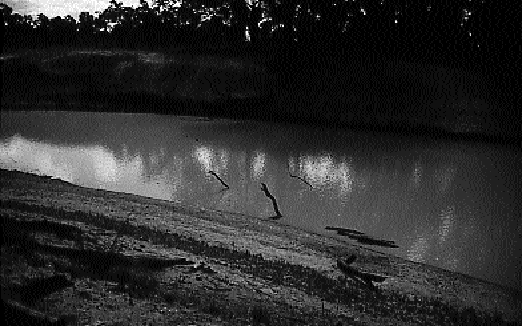
The Darling River
"Where we can boost native fish populations through improved flows we need to do it now. We can’t afford to wait until we have a silver bullet to control carp; we just need to recognise that the very flows that are supposed to be improving things for native fish may well provide an advantage for carp."
The results of this comprehensive study will be made available to the committees overseeing the Water Reform process currently underway in NSW.
A predictive model is currently being developed that will estimate the changes in fish communities brought about as a result of flow regime changes instigated by the NSW’s water reforms.
The final report of the Recruitment Ecology of Native Fish study is expected to be released by June this year.
For more information, please contact Peter Gehrke at the NSW Fisheries Research Institute, Cronulla on 02 9527 8447.
World Bank examine Australian water industry
 Peter Cullen Peter Cullen
The Australian water industry has impressed a contingent of World Bank experts with its ‘creativity’ and ‘innovation’. Indeed, the delegation of 50 from Washington and World Bank offices in Africa, Asia and South America voiced the sentiment that Australia seemed to be the only country where the complete range of World Bank water policies were actually being applied.
The delegation was conducting a two-week fact finding mission to explore the major reforms implemented by the Australian water industry during the last decade. The tour started with a plenary day in Canberra where the background of the National Competition Policy and the various water reforms were introduced by Murray-Darling Basin Commission Chief Executive, Don Blackmore, CRC for Freshwater Ecology Chairman, John Langford, and myself. The visitors split into two groups, one of which examined aspects of the urban industry in Canberra, Melbourne, Adelaide and Sydney. The other visited the Snowy Mountains and toured the southern parts of the Murray-Darling Basin. The two groups concluded their visit in Sydney where a plenary session allowed some of their impressions to be captured.
Most of the group had little prior knowledge of Australia or the Australian water industry. Given the absence of any particular crisis in the water industry, participants asked what were the factors that drove governments to adopt competition policies that led to so many of the changes they had witnessed.
The diversity of emerging models was noted, and the fact they were still evolving. It was thought that a number of models could be made to work, providing people were committed to change. One commentator suggested the diversity of water management models in Australia was a function of rapidly changing fashions in public administration and that the States embraced reforms at different times, sometimes emphasising service delivery and at other times regulation.
The visitors commented on the professionalism, commitment and energy
of the people they met. They were pleased to see how many people saw themselves as part of a comprehensive ‘water industry’, rather than as belonging to a single element of the industry.
Some questioned the value of breaking Melbourne into competing units; others wondered at the monolithic nature of Sydney Water and the out-sourcing approaches of Adelaide. The Australian experience was providing a major testing ground for emerging ideas and would certainly be watched with interest and evaluated carefully.
The group observed that Australia had moved beyond just selecting engineering fixes to water problems and was actively seeking solutions that delivered effective outcomes on a range of criteria.
The group was amazed at the level of community involvement, awareness and ownership in the Murray- Darling Basin. The largely shared vision for sustainable resource management was noted and many were interested in how this had been achieved. They found the Catchment Management Authority model in Victoria most interesting, and noted that NSW seemed some way behind in developing community structures. They also noted that it took time for such processes to grow and strengthen, and that seven to eight years was not unreasonable. They compared this with the very short times - often as little as two years - the World Bank used to try and achieve such ownership.
The group was very interested in the progress that Australia had made in the area of environmental allocations. They noted the effective transfer of science from the research providers to the managers needing the knowledge. The role that research had played in underpinning the water reforms was also noted.
The debate on cost-sharing attracted attention, and a view was expressed that governments should pay for the repair bills that resulted from the mistakes they had made in the past. There were other views about reflecting the full cost of production in prices rather than off-loading costs to downstream communities and to environmental degradation.
The visitors saw some unfinished business. They do not believe that Australia has yet implemented effective economic regulators.
The group was surprised at our failure to come to grips with cost-recovery, especially in the rural industry, given the widespread reforms and the wealth of Australia. There was also surprise that we were separating the hydro-electricity and the irrigation industries rather than attempting to integrate them.
Participants felt there were many aspects of the Australian experience that could be of value internationally, and will cause the Bank to reassess some of its own planning models.
These notes are my impressions of comments made from the plenary session. They do not necessarily represent a group consensus or a World Bank view.
Dipping into the ‘void’ of lowland river ecology
This large, multidisciplinary study will be conducted at three sites along lowland sections of the River Murray: one near Albury; another near the Barmah choke, either on the Murray or Edward rivers; and a third at Mildura, in Hatter National Park.
Scientists from the CRC for Freshwater Ecology are stepping into the scientific void in a bid to discover what makes Australian lowland rivers tick.
This multidisciplinary and collaborative project is part of the CRC for Freshwater Ecology’s new research portfolio, which has an emphasis on large, integrated studies - scientific work that Cooperative Research Centres are well placed to conduct.
The project, Ecological Functioning of Lowland River Systems, is being conducted by a team of 17 scientists from more than five CRC sites.

Dr Ben Gawne sampling on the River Murray.
Project leader, Dr Ben Gawne, said that the three-year project had been designed to look at the ‘big picture’ of lowland rivers.
"We’re asking some pretty basic but very big questions," Dr Gawne said. "Large lowland rivers, such as the Murray, have provided Australians with drinking water, transportation and agriculture for years.
Many of these rivers are now quite degraded. Despite our reliance on these rivers, we have very little idea of how they actually function."
A key part of the study is investigating where lowland rivers obtain their carbon supplies. Does litter from the floodplain provide the carbon that drives the lowland river ecosystem, or is that energy source fed into the river further upstream? What happens to the carbon once it’s in the system? And, if you change the type or amount of carbon that is in the river, does that have consequences for grazing animals or the predators in the system?
"So far as lowland rivers go, we’re stepping into unknown scientific territory," Dr Gawne said. "The lack of data on large rivers is partly due to the fact that they are notoriously difficult to sample.
"This project provides the ability to address a large-scale question, or number of large-scale questions, which just couldn’t be tackled by a small team or individuals."
The project brings together scientists from a range of disciplines including botanists, ecologists, a geomorphologist and algologists.
It will be conducted at three sites along lowland sections of the River Murray. The project team will investigate the quantity of organic carbon making its way into the river from five different sources:
1. The floodplain in the form of living and dead plant material
2. Fine matter and dissolved material from upstream
3. Attached algae on river bed, snags and macrophytes
4. Algae
5. Large aquatic plants
In addition, the study will look at what might cause the carbon from these different sources to vary over time and space.
Critical information - what sources or types of organic matter are important and what the consequences of changing these amounts might be to riverine life - will be provided by comparing and synthesising data from the five different parts of the study.
Dr Gawne said that a key goal of the project was to develop a database model that would enable water managers to predict the consequences of their management activities.
"Once you have a model of a river, you’re in a position to determine what the consequences will be if you start changing aspects of the river’s function," he said.
"You can plug a scenario into the model and then determine whether that will reduce or increase the productivity of a particular component and then see what the consequences might be. At the moment we’ve got no way of knowing what will happen when we change the management of our rivers.
"The model will give us some measure of predictive power. It will also provide us with some idea of what are the important processes in lowland rivers."
The answers to the riddles of lowland rivers are still some way off. Two scientists have recently been appointed to work on the project. Dr Chester Merrick joins the team from Warrnambool and will lend his expertise on algal ecology. Project technician, Patricia Bowen, has completed postgraduate work on seagrass ecology and community structures.
The first field trip is scheduled for the middle of June - when the scientists will have the opportunity to ‘test-drive’ and possibly refine their experimental work.
The project will also provide valuable information to a number of other CRCFE projects, including another large, integrated project that is investigating how nutrients, such as carbon, phosphorus and nitrogen, move into and out of lowland rivers.
Dr Ben Gawne is the officer-in-charge at the Lower Basin Laboratory of the Murray-Darling Freshwater Research Centre, based at Mildura.
CRCFE partners involved in the project include the Murray-Darling Freshwater Research Centre, the University of Canberra; Monash, La Trobe and Adelaide universities and CSIRO Land and Water.
Dr Gawne can be contacted by phone on (03) 5023 3870.
Manual launches algae on biomonitoring scene
While algae often get a bad ‘rap’ in the media, they are the latest in an arsenal of biological tools being used by natural resource managers to assess the health of our rivers.
In a bid to make certain types of algae more accessible as tools for river health monitoring, CRCFE researchers from La Trobe University have developed a manual for river managers using phytoplankton, to assess the health of Australian rivers.
Phytoplankton comprises all suspended microalgae in the water body, including blue-green algae, also known as cyanobacteria.
The Land and Water Resources Research and Development Corporation funded the development of the manual, A phytoplankton methods manual for Australian rivers, produced by Ms Gertraud Hötzel and Dr Roger Croome, under the umbrella of the Monitoring River Health Initiative.
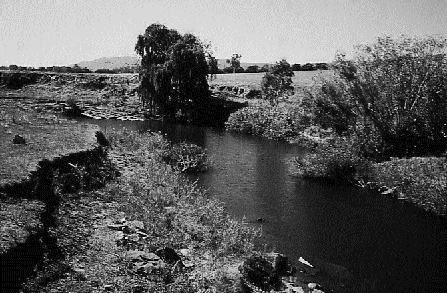
The upper Broken River.Thirty-one sites on streams in north-east Victoria and south-west NSW were sampled during this study which has produced a manual aimed at standardising the use of phytoplankton as a tool for assessing river health.
Ms Hötzel said that phytoplankton, as major primary producers in some parts of the river system, could provide managers with complementary information to that provided by sampling other groups of organisms, such as macroinvertebrates.
Overseas management agencies had been using algae such as phytoplankton for several decades to assess river health, Ms Hötzel said.
"All major European rivers, such as the Rhine, Rhone, Meuse and Danube, have ongoing phytoplankton monitoring programs," she said.
"Together with attached algae and aquatic plants, phytoplankton can often, in terms of energy and material input, form the basis of the food web in the middle reaches of rivers.
"In order to understand the biological functioning of individual rivers and detect changes in them, we need to investigate the development of their algal populations.
Phytoplankton can provide information about the nutrient status and other water quality variables."
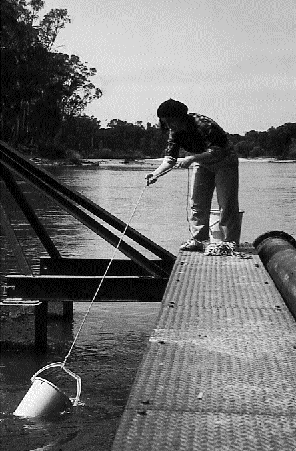
Sampling algae on the Murray River near Tocumwal. A manual has been produced which describes standardised methods for sampling, fixing, preserving, identifying and counting algae in Australian rivers.
Algae monitoring could also provide more specific information such as detecting the presence and population growth of potentially toxic blue-green algae so that appropriate warnings could be issued to irrigators and other water users.
The effects of management measures such as river regulation and water abstraction, as well as the impacts of land use activities on water quality could also be assessed through algal monitoring programs.
Ms Hötzel, who has many years of experience in algal work, consulted extensively with natural resource management agencies and other algal workers throughout the country during the development of the manual.
The manual describes standardised methods for sampling, fixing, preserving, identifying and counting algae in Australian rivers. It also recommends procedures for quality control and data storage. The National Association of Testing Laboratories (NATA), which was also involved in the consultation process, anticipates using the manual as the basis for its accreditation of algal analysing laboratories. Recommendations from the manual have also been included in the new version of the Australian New Zealand Environment and Conservation Council (ANZECC) water quality guidelines.
"Implementation of the manual will lead to greater uniformity in the methods being used in algal laboratories around the country," Ms Hötzel said.
"The protocol is flexible enough, however, to accommodate individual program objectives, client needs and available resources."
The 60-page manual includes sections on monitoring objectives, taking samples, analysis of samples, quality assurance, staff training as well as a comprehensive list of algal taxonomic literature for Australia.
For more information about the manual, phone Ms Gertraud Hötzel at La Trobe University on 02 6058 3877, or contact her by email on t.hotzel@aw.latrobe.edu.au
‘Average’ report card on Namoi catchment
Many of the streams in the Namoi catchment are in ‘average’ condition, a recent multidisciplinary study of this northern NSW catchment has found.
The 12-month study, conducted for the NSW Department of Land and Water Conservation (DLWC) by Dr Martin Thoms and Mr Chris Williams of the CRC for Freshwater Ecology, examined and assessed the ecological processes within the Namoi River and its major tributaries.
Project leader, CRCFE geomorphologist Dr Martin Thoms, said that the Index of Stream Condition (ISC), developed by the Victorian Department of Natural Resources and Environment and modified for this project, was used to provide a holistic assessment of the condition of streams within the catchment.
Some 18 sites on six rivers were surveyed and sampled over six months. Historical data, including river channel cross-sections, aerial photographs and discharges were provided by the DLWC.
Five categories, or sub-indices, were used to provide an overall assessment of stream health:
1. Geomorphology (physical form)
2. Streamside vegetation
3. Water quality
4. Aquatic life (invertebrates)
5. Hydrology
"It’s the first time all this information has been cobbled together in these northern catchments," Dr Thoms said.
"The way it works is that we assess and score each of the sub-indices. We then bring it all together to come up with a total score, which provides an overall indication of how the stream is fairing. A site which scores under 25 is considered in poor condition, while a score of 25-35 would indicate that the site was in good condition, and 36-50 in excellent condition.
"If the total score is low, we can go back to the sub-indices to determine why the stream is in poor health. Or if the total score is high, but one or two of the sub-indices are low, management objectives may be focused on these ‘problem areas’ within a catchment.
"This work is not only giving us a benchmark of the condition of streams in the catchment, it is also providing a means of prioritising management activities. It sharpens the focus in terms of bang for bucks."
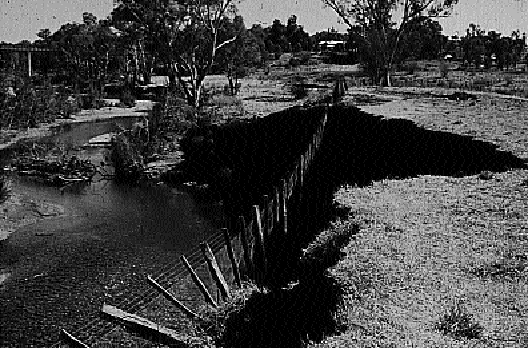
Bank erosion on the Gwydir River near Bundarra. River regulation, the recent study found, is a major contributing factor to bank erosion.
Almost half of the sites examined within the Namoi catchment were assessed as being in poor condition, according to the ISC results. About one-third of the sites were in good condition, although all of these sites scored less than 29. Just 22% of sites were rated as excellent.
Dr Thoms said that generally the upland sites were in excellent condition while the lowland sites in heavy agricultural areas were assessed as poor.
"Major impacts within the Namoi catchment include degraded riparian zones, or in some places, where land is cultivated right up to the river’s edge, a complete lack of riparian zone," he said.
"The effects of dams and river regulation are reflected in the low scores received by both the physical and aquatic life indices.
"The biodiversity of bug (macroinvertebrates) communities tends to be adversely affected by cold water releases from dams and regulation, which alters habitat conditions. Bank erosion and river bed instability are other by-products of regulation.
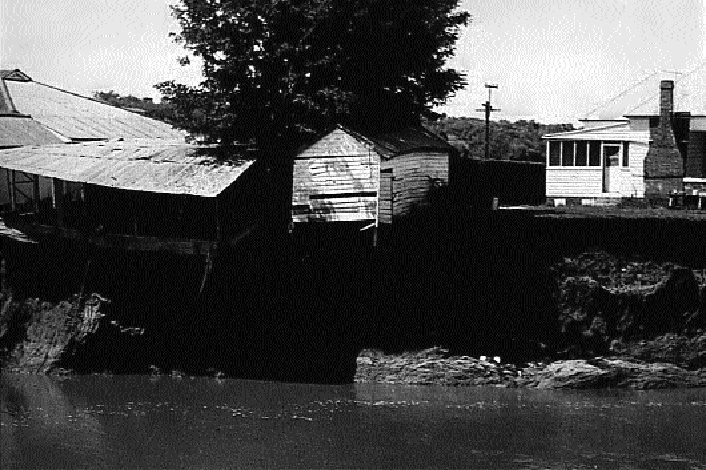
The dramatic effects of bank erosion. River health assessment helps managers prioritise rehabilitation activities.
CRCFE scientific officer, Chris Williams, who conducted much of the sampling and number-crunching, said that the results really demonstrated the ‘power’ of the ISC.
"The macroinvertebrate communities appeared to be quite healthy at many of the sites sampled," Mr Williams said. "However, when you step back and look at it you can see land use impacts on the streamside vegetation. Often, the extent of impacts has to be quite significant to have a major impact on the bugs."
Dr Thoms said that restoring flows to more natural conditions was one management option that would help restore the condition of streams in the Namoi catchment.
"In the recent past, wetlands and marshes have received a lot of attention and water has been allocated to these waterbodies," he pointed out. "But we can’t neglect the river channel and use it as a conduit to provide water to marshes."
The results of this study, The condition of the Namoi River system, will soon be available from the DLWC.
Further work of this nature has commenced on the Gwydir, another northern NSW river. There are also plans to extend this study to all rivers within the Darling Basin.
CONTACTS
Director:
Prof Peter Cullen
University of Canberra
PO Box 1
BELCONNEN ACT 2616
Phone: (06) 201 5168
Fax: (06) 201 5038
Email:
cullen@lake.canberra.edu.au
Dr Terry Hillman
Deputy Director/ Program Leader
Floodplain and Wetland Ecology
Murray-Darling Freshwater
Research Centre
PO Box 921
ALBURY NSW 2640
Ph: 060 58 2312
Fax: 060 431 626
Email:
terryh@mdfrc.canberra.edu.au
Professor Barry Hart
Deputy Director/Program Leader
Water Quality and
Ecological Assessment
Water Studies Centre
Monash University
PO Box 197
CAULFIELD EAST VIC 3145
Ph: 03 9903 2326
Fax: 03 9571 3646
Email: barry.hart@sci.monash.edu.au
Articles in Watershed may be reproduced without prior permission provided the article is reproduced in full and the source is acknowledged.
Editor: Karen Markwort
Communication Manager
CRC for Freshwater Ecology
University of Canberra
PO Box 1
BELCONNEN ACT 2616
Email: karenm@lake.canberra.edu.au
|